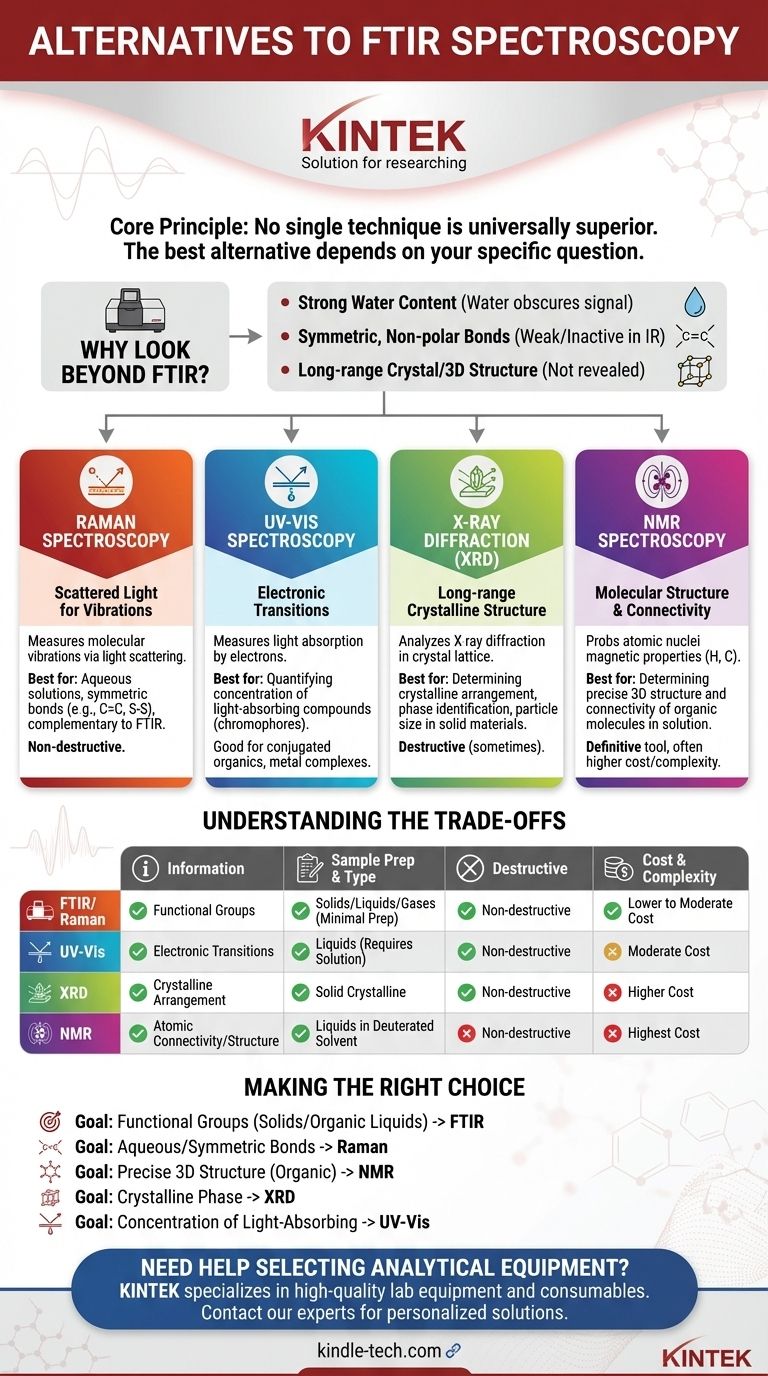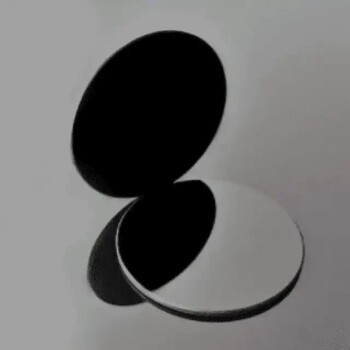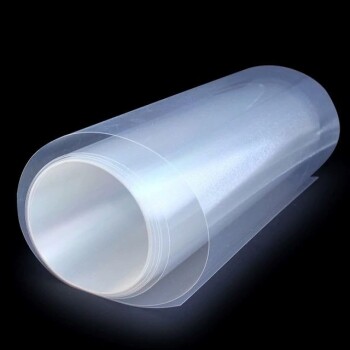The primary alternatives to FTIR spectroscopy are Raman Spectroscopy, UV-Vis Spectroscopy, X-ray Diffraction (XRD), and Nuclear Magnetic Resonance (NMR) Spectroscopy. These techniques, like FTIR, are used to characterize materials, but they each probe different physical properties of a sample to answer distinct questions about its composition and structure.
The core principle is that no single technique is universally superior. The best alternative to FTIR depends entirely on the specific information you need—whether it's about molecular bonds, electronic transitions, crystal structure, or atomic connectivity.

Why Look Beyond FTIR?
FTIR (Fourier-Transform Infrared) spectroscopy is an exceptionally powerful and common technique. It excels at identifying the functional groups within a molecule by measuring how its chemical bonds absorb infrared light. However, you may need an alternative when facing its inherent limitations.
Inherent Weaknesses of FTIR
FTIR is often not the ideal choice if your sample involves strong water content, as water is a very strong IR absorber and can obscure the signal from your sample.
Additionally, certain molecular bonds, particularly symmetric, non-polar bonds (like C=C in ethene or S-S bonds), are very weak or inactive in IR spectroscopy, making them difficult to detect.
Finally, FTIR provides information on chemical bonds, but it does not reveal the long-range crystal structure or the precise 3D atomic arrangement of a complex molecule.
Key Alternatives and Their Core Strengths
Each alternative provides a unique window into the properties of a material. Understanding what each one measures is the key to selecting the right tool.
Raman Spectroscopy
Raman is the most direct alternative to FTIR because it also measures molecular vibrations. Instead of measuring light absorption, however, it measures the scattering of light.
This fundamental difference makes Raman highly effective for analyzing aqueous solutions and materials with symmetric bonds that are invisible to FTIR. It is often considered a complementary, rather than a competitive, technique.
UV-Vis Spectroscopy
Ultraviolet-Visible (UV-Vis) spectroscopy measures how a sample absorbs UV or visible light. This absorption is caused by electronic transitions within the molecule, not bond vibrations.
Its primary strength is in quantifying the concentration of a known substance in a solution, especially for compounds with chromophores (parts of a molecule that absorb light), like conjugated organic molecules or transition metal complexes.
X-ray Diffraction (XRD)
XRD has a completely different purpose. It provides no information about specific chemical bonds. Instead, it reveals the long-range atomic structure of crystalline materials.
By analyzing how X-rays are diffracted by the atoms in a crystal lattice, XRD can identify the phase of a material (e.g., distinguishing between different forms of titanium dioxide), determine crystal structure, and measure particle size.
Nuclear Magnetic Resonance (NMR) Spectroscopy
NMR is the definitive tool for determining the detailed molecular structure and connectivity of organic molecules in solution.
It works by probing the magnetic properties of atomic nuclei (typically hydrogen and carbon). The resulting spectrum provides a precise map of the chemical environment for each atom, allowing chemists to piece together the exact structure of a molecule.
Understanding the Trade-offs
Choosing a technique requires a clear understanding of what you gain and what you give up with each option.
Information Provided
FTIR and Raman reveal a molecule's functional groups (vibrational information). NMR provides a detailed map of the atomic structure and connectivity. XRD determines the crystalline arrangement and phase. UV-Vis identifies electronic transitions, which is useful for quantification.
Sample Preparation and Type
FTIR and Raman are versatile, analyzing solids, liquids, and gases with minimal preparation. NMR typically requires dissolving the sample in a deuterated solvent. XRD is primarily used for solid, crystalline materials.
Destructive vs. Non-Destructive
Most of these techniques, including FTIR, Raman, and XRD, are non-destructive, meaning you can recover your sample after analysis. This is a significant advantage when working with precious materials.
Cost and Complexity
FTIR instruments are generally the most accessible and affordable, making them a workhorse in many labs. Raman and UV-Vis systems are also relatively common. NMR and XRD instruments represent a significantly higher investment in cost, facility requirements, and operator expertise.
Making the Right Choice for Your Goal
Your analytical goal should be the sole driver of your decision.
- If your primary focus is identifying functional groups in a solid or organic liquid: FTIR remains the first and best choice due to its speed and simplicity.
- If your primary focus is analyzing a sample in water or identifying symmetric bonds: Raman spectroscopy is the superior alternative.
- If your primary focus is determining the precise 3D structure of a novel organic compound: NMR is the undisputed standard.
- If your primary focus is identifying the crystalline phase of a mineral or polymer: XRD is the only technique that can provide this information.
- If your primary focus is measuring the concentration of a known, light-absorbing compound in a solution: UV-Vis spectroscopy is the most direct and efficient tool.
Choosing the right analytical tool begins with clearly defining the question you need your sample to answer.
Summary Table:
| Technique | Primary Information Provided | Best For |
|---|---|---|
| Raman Spectroscopy | Molecular vibrations (complementary to FTIR) | Aqueous solutions, symmetric bonds |
| UV-Vis Spectroscopy | Electronic transitions | Quantifying concentration of light-absorbing compounds |
| X-ray Diffraction (XRD) | Crystalline structure, phase identification | Solid, crystalline materials |
| NMR Spectroscopy | Atomic connectivity, molecular structure | Determining precise 3D structure of organic molecules |
Need help selecting the right analytical equipment for your lab?
KINTEK specializes in providing high-quality lab equipment and consumables to meet your specific research and analysis needs. Whether you're considering FTIR, Raman, NMR, or any other spectroscopy technique, our experts can help you find the perfect solution to enhance your lab's capabilities and efficiency.
Contact us today for a personalized consultation and let us help you make the right choice for your laboratory. Get in touch via our contact form!
Visual Guide

Related Products
- Three-dimensional electromagnetic sieving instrument
- Lab Electrochemical Workstation Potentiostat for Laboratory Use
- Infrared High Resistance Single Crystal Silicon Lens
- Thin-Layer Spectral Electrolysis Electrochemical Cell
- Infrared Thermal Imaging Temperature Measurement Double-Sided Coated Germanium Ge Lens
People Also Ask
- What does a vibrating sieve do? Automate Particle Size Analysis for Accurate Results
- What is the speed of a sieving machine? Optimize Vibration for Maximum Efficiency and Accuracy
- What is the operating procedure of a sieve shaker? Master Accurate Particle Size Analysis
- What is powder sieving? A Guide to Accurate Particle Size Separation
- What are the disadvantages of sieve machine? Key Limitations in Particle Size Analysis


















